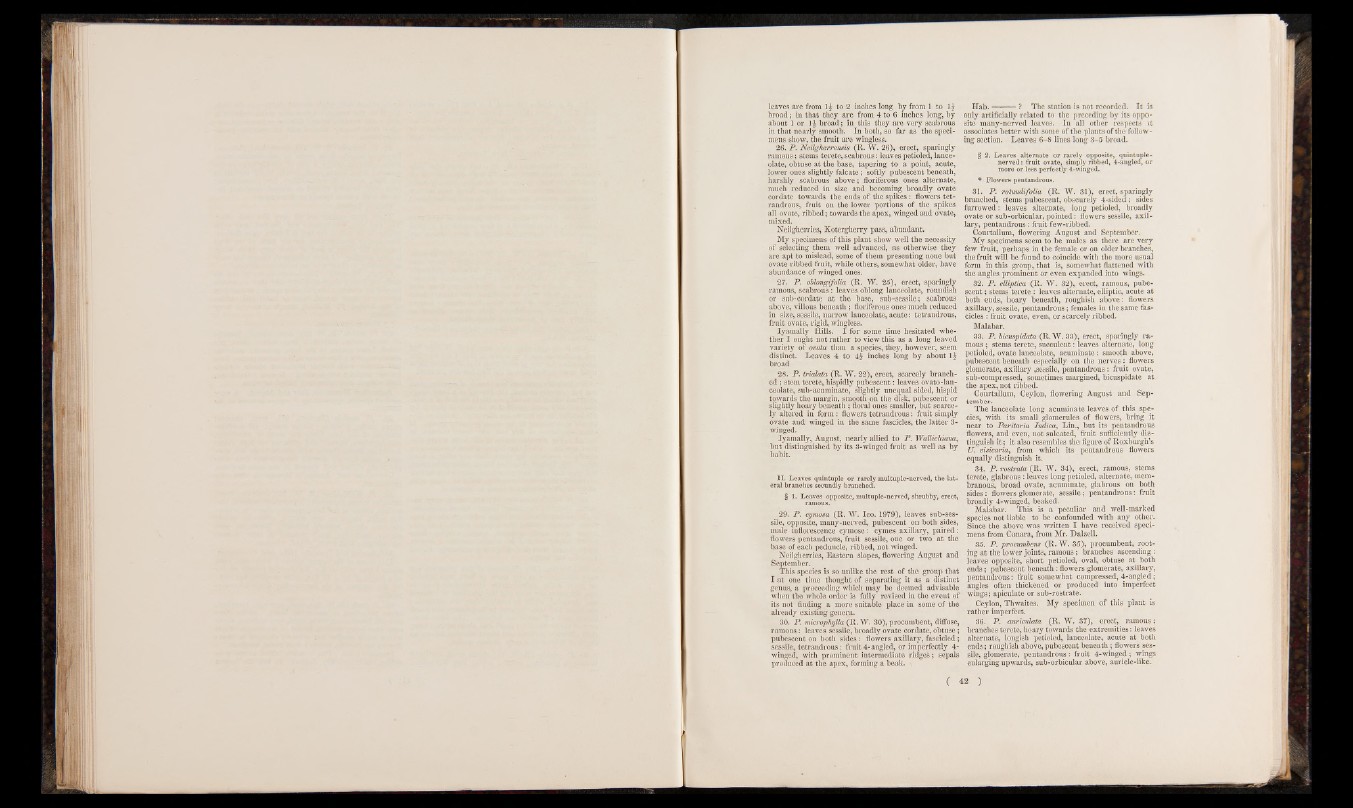
leaves are from l£ to 2 inches long by from 1 to 1£
broad; in that they are from 4 to 6 inches long, by
about 1 or 1£ broad; in this they are very scabrous
in that nearly smooth. In both, so far as the specimens
show, the fruit are wingless.
26. P . Neilgherrensis (R. W. 26), erect, sparingly
ramous; stems terete,scabrous: leaves petioled, lanceolate,
obtuse at the base, tapering to a point, acute,
lower ones slightly falcate; softly pubescent beneath,
hai’shly scabrous above; floriferous ones alternate,
much reduced in size and becoming broadly ovate
cordate towards the ends of the spikes: flowers tet-
randrous, fruit on the lower portions of the spikes
all ovate, ribbed; towards the apex, winged and ovate,
mixed,
jSFeiigherries, Kotergherry pass, abundant.
My specimens of this plant show well the necessity
of selecting them well advanced, as otherwise they
are apt to mislead, some of them presenting none but
ovate ribbed fruit, while others, somewhat older, have
abundance of winged ones.
27. P. oblongifolia (R. W. 25), erect, sparingly
ramous, scabrous: leaves oblong lanceolate, roundish
or sub-cordate at the base, sub-sessile; scabrous
above, villous beneath; floriferous ones much reduced
in size, sessile, narrow lanceolate, acute: tetrandrous,
fruit ovate, rigid, wingless.
Iyamally Hills; I for some time hesitated whether
I ought not rather to view this as a long leaved
variety of ovata than a species, they, however, seem
distinct. Leaves 4 to 4£ inches long by about l£
broad
28. P . trialata (R. W. 22), erect, scarcely branched
; stem terete, hispidly pubescent: leaves ovato-lan-
ceolate, sub-acuminate, slightly unequal sided, hispid
towards the margin, smooth on the disk, pubescent or
slightly hoary beneath; floral ones smaller, but scarcely
altered in form: flowers tetrandrous: fruit simply
ovate and winged in the same fascicles, the latter 3-
winged.
Iyamally, August, nearly allied to P . Wallichiana,
but distinguished by its 3-winged fruit as well as by
habit.
II. Leaves quintuple or rarely multuple-nerved, the lateral
branches secundly branched.
§ 1. Leaves opposite, multuple-nerved, shrubby, erect,
ramous.
29. P . cymosa (R. W. Ico. 1979), leaves sub-sessile,
opposite, many-nerved, pubescent on both sides,
male inflorescence cymose: cymes axillary, paired:
flowers pentandrous, fruit sessile, one or two at the
base of each peduncle, ribbed, not winged.
Neilgherries, Eastern slopes, flowering August and
September.
This species is so unlike the rest of the group that
I at one time thought of separating it as a distinct
genus, a proceeding which may be deemed advisable
when the whole order is fully revised in the event of
its not finding a more suitable place in some of the
already existing genera.
30. P . microphylla (R. W. 30), procumbent, diffuse,
ramous: leaves sessile, broadly ovate cordate, obtuse;
pubescent on both sides : flowers axillary, fascicled;
sessile, tetrandrous: fruit 4-angled, or imperfectly 4-
winged, with prominent intermediate ridges; sepals
produced at the apex, forming a beak. \
H a b .---------? The station is not recorded. I t is
only artificially related to the preceding by its opposite
many-nerved leaves. In all other respects it
associates better with some of the plants of the following
section. Leaves 6-8 lines long 3-5 broad.
§ 2. Leaves alternate or rarely opposite, quintuple-
nerved: fruit ovate, simply ribbed, 4-angled, or
more or less perfectly 4-winged.
* Flowers pentandrous.
31. P . rotundifolia (R. W. 31), erect, sparingly
branched, stems pubescent, obscurely 4-sided; sides
furrowed: leaves alternate, long petioled, broadly
ovate or sub-orbicular, pointed: flowers sessile, axillary,
pentandrous: fruit few-ribbed.
Courtallum, flowering August and September.
My specimens seem to be males as there are very
few fruit, perhaps in the female or on older branches,
the fruit will be found to coincide with the more usual
form in this group, that is, somewhat flattened with
the angles prominent or even expanded into wings.
32. P . elliptica (R. W. 32), erect, ramous, pubescent
; stems tere te: leaves alternate, elliptic, acute at
both ends, hoary beneath, roughish above: flowers
axillary, sessile, pentandrous; females in the same fascicles
: fruit ovate, even, or scarcely ribbed.
Malabar.
33. P. bicuspidata (R. W. 33), erect, sparingly ramous
; stems terete, succulent: leaves alternate, long
petioled, ovate lanceolate, acuminate: smooth above,
pubescent beneath especially on the nerves: flowers
glomerate, axillary,sessile, pentandrous: fruit ovate,
sub-compressed, sometimes margined, bicuspidate at
the apex, not ribbed.
Courtallum, Ceylon, flowering August and September.
The lanceolate long acuminate leaves of this species,
with its small glomerules of flowers, bring it
near to Paritaria Indica, Lin., but its pentandrous
flowers, and even, not sulcated, fruit sufficiently distinguish
i t ; it also resembles the figure of Roxburgh’s
U. visicaria, from which its pentandrous flowers
equally distinguish it.
34. P . rostrata (R. W. 34), erect, ramous, stems
terete, glabrous: leaves long petioled, alternate, membranous,
broad ovate, acuminate, glabrous on both
sides: flowers glomerate, sessile; pentandrous: fruit
broadly 4-winged, beaked.
Malabar. This is a peculiar and well-marked
species not liable to be confounded with any other.
Since the above was written I have received specimens
from Canara, from Mr. Dalzell.
35. P . procumbens (R. W. 35), procumbent, rooting
at the lower joints, ramous; branches ascending:
leaves opposite, short petioled, oval, obtuse at both
ends; pubescent beneath: flowers glomerate, axillary,
pentandrous: fruit somewhat compressed, 4-angled;
angles often thickened or produced into imperfect
wings; apiculate or sub-rostrate.
Ceylon, Thwaites. My specimen of this plant is
rather imperfect.
36. P . auriculata (R. W. 37), erect, ramous;
branches terete, hoary towards the extremities: leaves
alternate, longish petioled, lanceolate, acute at both
ends; roughish above, pubescent beneath; flowers sessile,
glomerate, pentandrous: fruit 4-winged; wings
enlarging upwards, sub-orbicular above, auricle-like.